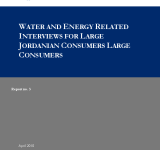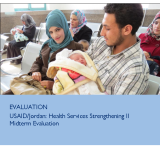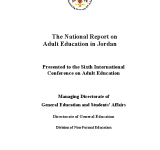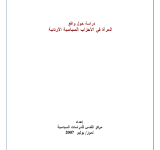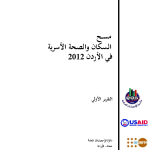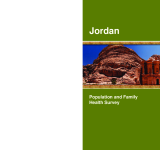The report aims to better understand and quantify the attitude and the levels of awareness amongst large consumers of water and energy;; and it presents the findings of the interviews conducted with a representative sample of large consumers to better understand trends and behaviors related to water and energy consumption. The research was conducted as part of the Jordan Public Action in Water;; Energy;; and Environment Project (PAP) under the Prosperity;; Livelihoods;; and Conserving Ecosystems (PLACE);; which aims to initiate and establish clear and identifiable behavioral changes amongst the Jordanian public and decision-makers. The study categorizes large consumers into a number of main sectors including hotel and restaurant sectors;; commercial sector;; hospitals;; government buildings and industrial sector;; and the field surveys were collected as a random sample of different industries;; state and commercial buildings. The research finds that the majority of large consumers neither monitor their water nor their energy consumptions via sub-metering scheme;; showing that the majority of large consumers are not able to accurately determine the areas within their establishments that are the most consuming. This finding identifies four major obstacles in implementing the water and energy saving practices including;; lack of awareness;; lack of incentive programs amongst employees;; higher prices for higher quality savings devices and lack of proper maintenance.
programs
The report presents the findings;; conclusions and recommendations of a midterm evaluation of Health Systems Strengthening (HSS) II;; a five year (2009-2014);; $73 million USAID-funded project. The strategy of the HSS II is to institutionalize strengthened health systems in support of reduced fertility rates and improved women's health. It works with the public health sector;; namely the Ministry of Health;; the Royal Medical Service and the Jordan University Hospital. The report finds that the project has met 13 of its 23 targets for year 3 and is on track to meet all its objectives by the end of the project. Expected results are public sector initiatives in safe motherhood and reproductive health. The HSS II project;; with its close ties with the Ministry of Health for its responsiveness to health needs and integrated approach to health delivery;; has strengthened critical health systems through its support to health management information system;; renovations;; accreditation;; referrals and capacity-building. The report recommends the USAID to negotiate the removal of a requirement that midwives be supervised intrauterine device insertion;; advocate for innovative incentive schemes and varying salary grades that reward midwives and doctors providing FP services and revise project indicators to reflect health outcomes and impact. Further recommendations include continuing support of a broad-scale mass media behavior change and communication campaign and programs that build on gains in maternal and neonatal health.
This paper aims at shedding light on the labor rights in Jordan;; particularly for those who are working in the informal sector;; through identifying the factors that impede them from enjoying such rights and;; thus;; coming up with the appropriate recommendations in this area.
This national report on Adult Education in Jordan;; is a report presented to the Sixth International Conference on Adult Education. It presents Jordanian educational legislation;; strategies;; policies and laws as well as educational projects and programs. The main theme of this report is the right of education.
دراسة مسحية استطلاعية حول واقع المرأة في الأحزاب السياسية الأردنية. وهذه الدراسة المسحية كانت من شقين: توزيع استبانة على عينة تضم 113 حزبية ينتمين الى 17 حزبا من أصل 35 حزباً سياسياً;; واجراء مقابلات مع عدد من الحزبيات حول واقع مشاركة المرأة في الأحزاب والمعيقات التي تواجهها. وفيما يتعلق بالجانب النظري للدراسة فإنه يستعرض المرأة في برامج الأحزاب السياسية الأردنية;; وشمل ذلك المرأة في ادبيات 18 حزباً من مختلف الاتجاهات. وقد أظهرت النتائج ضعف تمثيل المرأة في الاحزاب لعدة عوامل سياسية واجتماعية واقتصادية اضافة إلى عوامل تتعلق بالمراة ذاتها. وكما قدمت الدراسة مجموعة من التوصيات وكانت على أربعة مستويات: المجتمع الاردني;; والحكومة الأردنية;; والأحزاب الأردنية;; والمرأة نفسها.
يتمثل الهدف الرئيسي من هذا المسح في توفير بيانات شاملة وتقديرات موثوقة للمؤشرات الديموغرافية مثل الإنجاب والوفاة وتنظيم الأسرة;; وصحة وتغذية الأم والطفل بوصفها أداة لتقييم البرامج والسياسات السكانية والصحية الموجودة حالياً. تم اعتماد منهجية المسح باستخدام استمارة للأسرة واستمارة أخرى فردية;; حيث تم مقابلة 15000 أسرة وأكثر من 11000 سيدة سبق لهن الزواج وعمرهن 15-49 سنة وذلك من خلال اشهر ايلول الى كانون الأول 2012. ويقدم هذا التقرير بعض النتائج الأولية لمسح عام 2012.
يلخض هذا التقرير نتائج مسح السكان والصحة الأسرية في الأردن 2009 الذي أجرته دائرة الاحصاءات العامة. ونفذ هذا المسح ضمن برنامج المسوح الديموغرافية والصحية الذي صمم لجمع بيانات عن الانجاب وتنظيم الأسرة وصحة الأمهات ووفيات الأطفال والرضع والحالة التغذوية بين النساء والأطفال. تم مقابة عينة ممثلة من الأسر على مستوى المملكة بلغت 13577 أسرة;; وكذلك 10109 سيدة سبق لهن الزواج ضمن الفئة العمرية 15-49 سنة;; وتوفر هذه العينة تقديرات على مستوى المملكة ككل وعلى مستوى الحضر والريف ومناطق البادية والأقاليم الثلاثة;; وعلى مستوى المحافظات.
